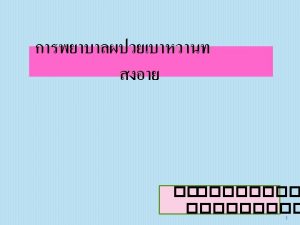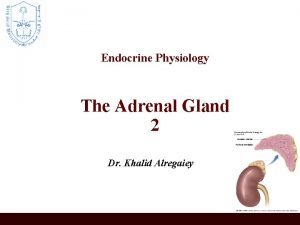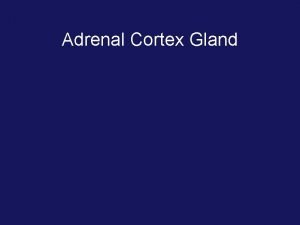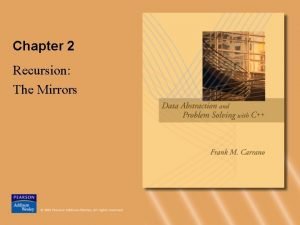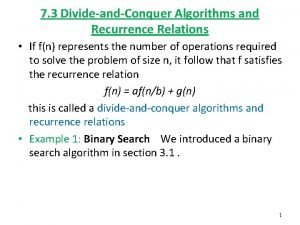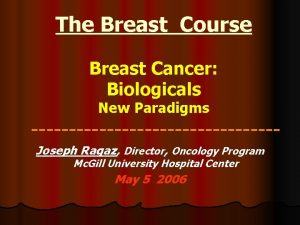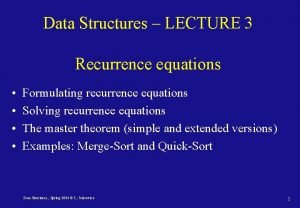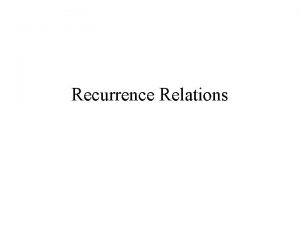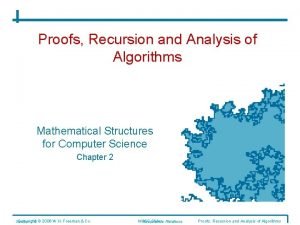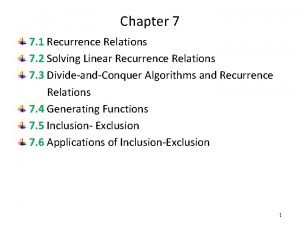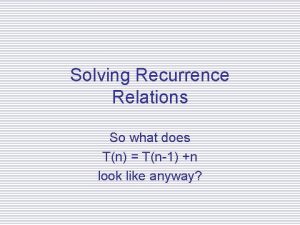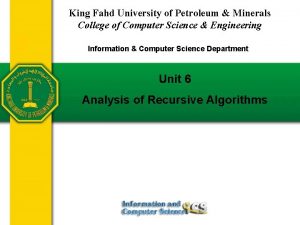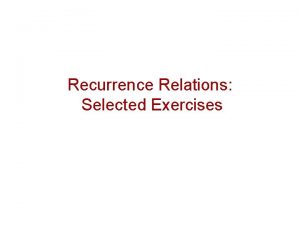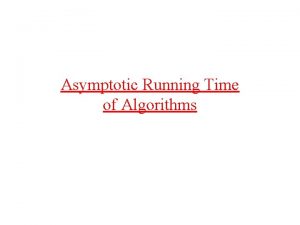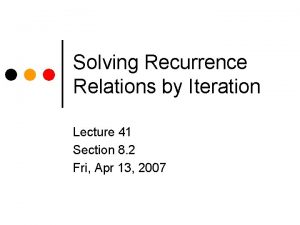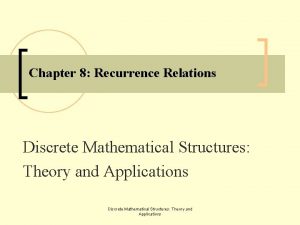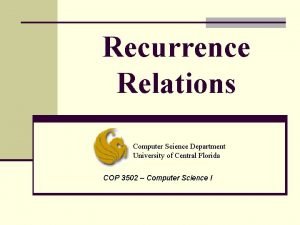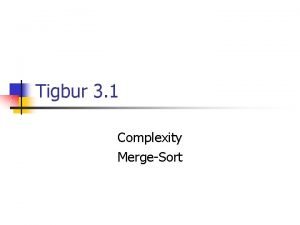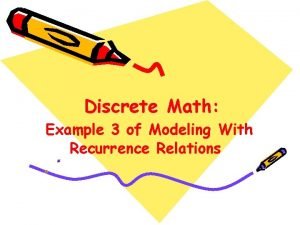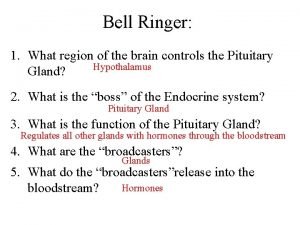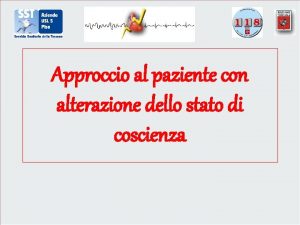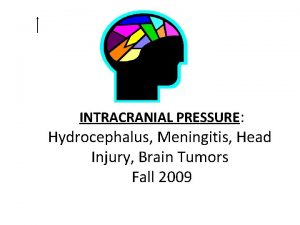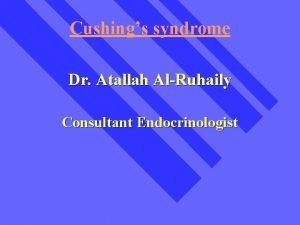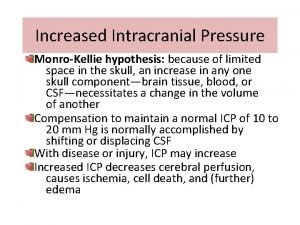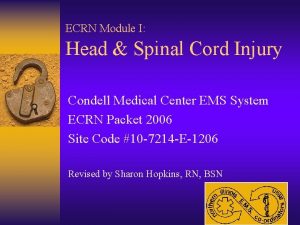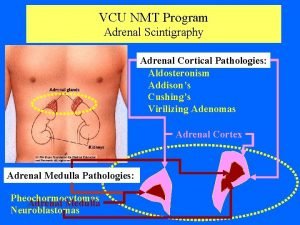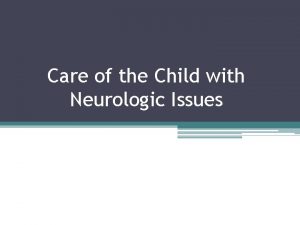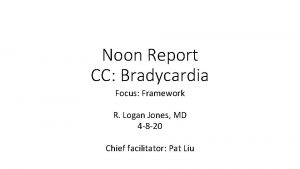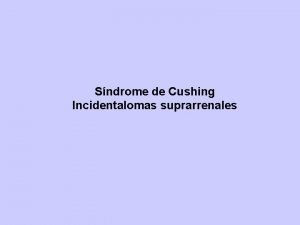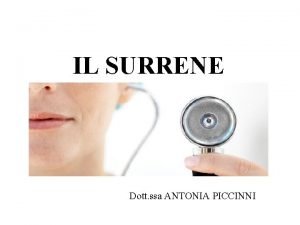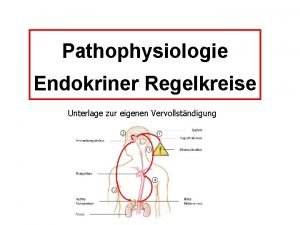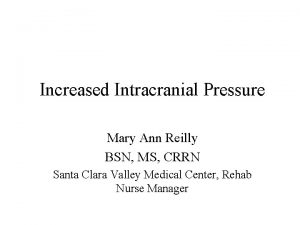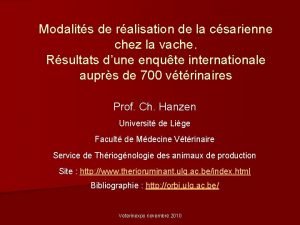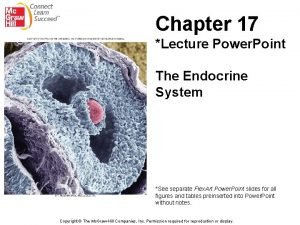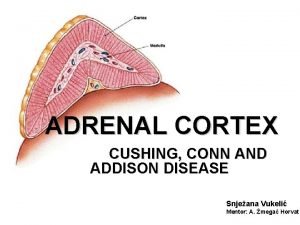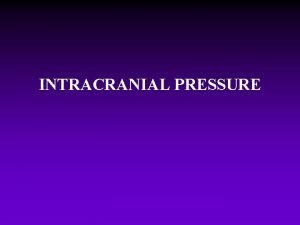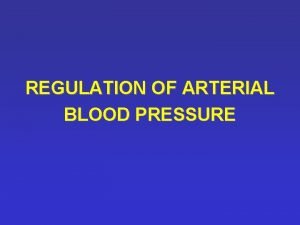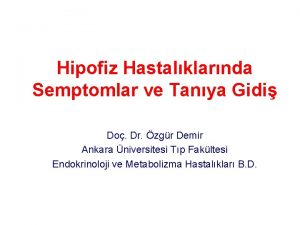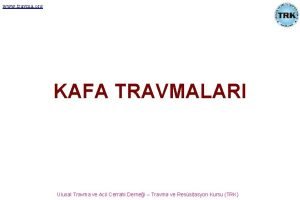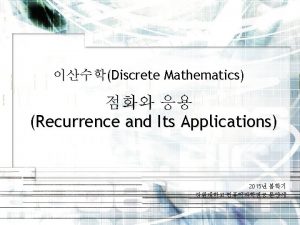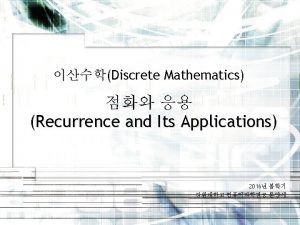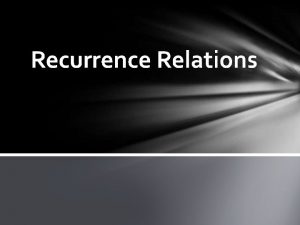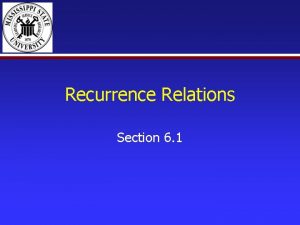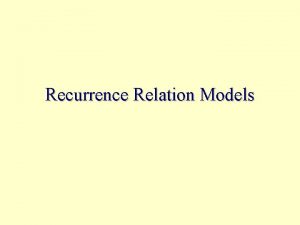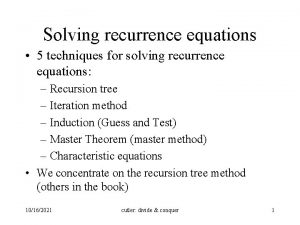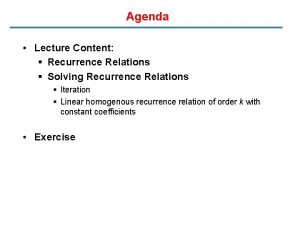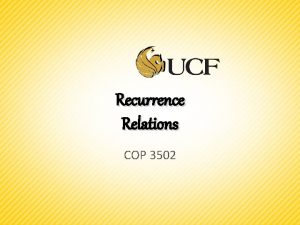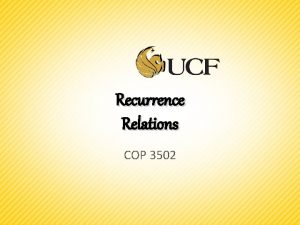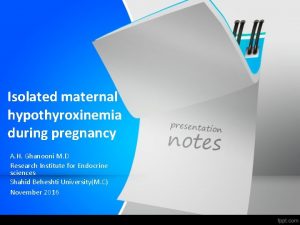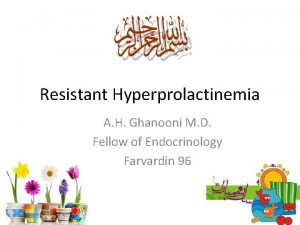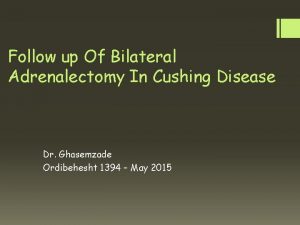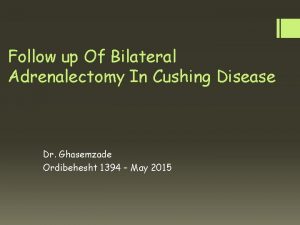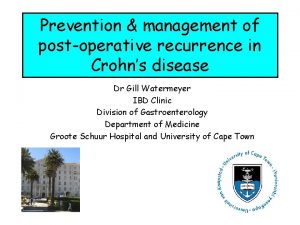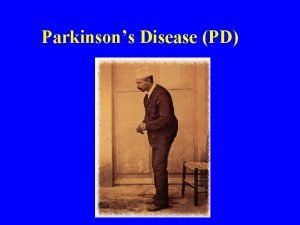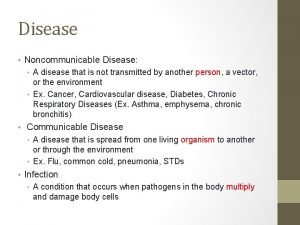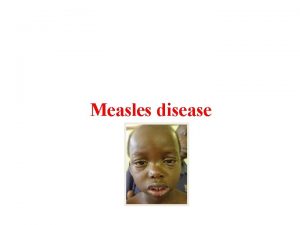RECURRENCE IN CUSHING DISEASE A H Ghanooni M

























































- Slides: 57

ﺍﻟﺮﺣﻴﻢ ﺍﻟﺮﺣﻤﻦ ﺍﻟﻠﻪ ﺑﺴﻢ RECURRENCE IN CUSHING DISEASE A. H. Ghanooni M. D Fellow of endocrinology February 2017

Agenda • Cushing disease and mortality • defining and rate of remission after surgery, • Rate of recurrent CD after surgery and dependant factors • challenges in diagnosing early recurrent hypercortisolemia. • evaluate a patient with CD recurrence as well as the risk benefit ratio of repeat surgery

Cushing disease and mortality • If untreated, the death rate may approach 50% at 5 years • standard mortality ratio (SMR) of 2. 5 (95% confidence interval 1. 4 -4. 2). • Mortality appears to remain higher in patients with CD even after initial biochemical remission • Hypopituitarism, including persistent adrenal insufficiency (AI) after surgery, has also been suggested to enhance the mortality risk.


• from 1975 to 2014 • Eight cohort studies • 766 patients were included.



Agenda • Cushing disease and mortality • defining and rate of remission after surgery • Rate of recurrent CD after surgery and dependant factors • challenges in diagnosing early recurrent hypercortisolemia. • evaluate a patient with CD recurrence as well as the risk benefit ratio of repeat surgery

ASSESSING REMISSION AFTER PITUITARY SURGERY IN CD • Criteria for disease remission vary significantly from study to study but include: Ø resolution of clinical symptoms related to hypercortisolism Ø need for corticosteroid replacement for >6 months after TSS Ø hypocortisolemia/eucortisolemia Ø the presence of clinical and laboratory signs of low serum cortisol and AI v Low serum cortisol in the immediate postoperative period and normal UFC and LNSC appear to have a higher sensitivity and specificity for determining remission compared to other biochemical markers. Diagnosing Recurrent Cushing Disease, Endocr Pract. 2016; 22(No. 12) 1437


• 44 studies with clear definitions of remission and recurrence. • 6400 patients





No change in remission rate was observed by decade of publication date (r=0. 2; P=NS)

Agenda • Cushing disease and mortality • defining and rate of remission after surgery, • Rate of recurrent CD after surgery and dependant factors • challenges in diagnosing early recurrent hypercortisolemia. • evaluate a patient with CD recurrence as well as the risk benefit ratio of repeat surgery



Key messages • remission (42. 0– 96. 6%; median, 77. 9%) and recurrence (0– 47. 4%; median, 11. 5%). • Better remission and recurrence outcomes were achieved for microadenomas vs macroadenomas; • however, no correlations were found with other parameters, other than improved safety with longer surgical experience.



key message • • In 74 studies (from 1976 to 2014) totaling 6, 091 CD patients treated with TSS as first-line therapy, the recurrence rates ranged from 0 to 65. 5% (mean 13. 4%, median 10. 6%). Interpretation of this data summary is significantly limited by the heterogeneity of the studies included, definition of recurrence, number of patients in each study (range 6 -668) and duration of follow-up (1 -444 months, median 54. 6 months).

Key Messages • Recurrence of hypercortisolemia after initial treatment of Cushing disease (CD) is more common than previously thought, with a third of patients suffering a recurrence over their lifetime. • Awareness of this high rate and delayed timeline (sometimes decades) of potential recurrence is critical and patients with CD should be monitored at regular intervals throughout their lives. Diagnosing Recurrent Cushing Disease, Endocr Pract. 2016; 22(No. 12) 1437

Effective factors on remission & recurrence • Rates of surgical remission depend significantly on: – tumor size – location of tumor – neurosurgeon skill and experience – the biochemical criteria used to assess remission

• The effect of tumor size on recurrence : • As with remission, slightly better outcomes were seen with microadenomas than with macroadenomas; • a slightly higher but not statistically significant recurrence rate (17. 6%; 19/108 patients; range 0. 0– 80%) was reported in patients with macroadenomas compared with those with microadenomas (13. 4%; 101/752 patients; range 2. 0– 35%).

• The effect of surgical experience: • the highest recurrence rate (13. 6%) was seen when ten or fewer patients were operated per year of study duration (in 18 studies), • while the lowest rate (6. 7%) was seen when 31– 40 patients were operated per year of study duration (r 2=0. 3; P=NS; albeit these data are from only two studies)


• Predict recurrence in remission by biochemical criteria • no cut-off values seem predictive of which patients will experience recurrence, • lower postoperative serum cortisol levels are associated with a lower risk of recurrence. • The addition of ACTH to cortisol measurements may increase the accuracy of remission assessments. • Although an early postoperative plasma ACTH level <20 pg/m. L has been suggested as an additional criteria predicting long-term remission , this finding has not been noted in all studies.

Predict recurrence in remission by biochemical criteria Diagnosing Recurrent Cushing Disease, Endocr Pract. 2016; 22(No. 12) 1437


• • a retrospective analysis based on the case records of 230 patients with CS 1983– 2014 mean follow-up time was 8 years included 91 patients of the three subtypes of CS undergoing curative intended surgery • Results: The probability of recovering adrenal function within a 5 years follow up (P =. 001) : – 82% in ectopic CS, – 58% in CD – 38% in adrenal CS. • median time to recovery (P =. 002) : – 0. 6 years (interquartile range [IQR], 0. 03– 1. 1 y) in ectopic CS – 1. 4 years (IQR, 0. 9 – 3. 4 y) in CD – 2. 5 years (IQR, 1. 6 – 5. 4 y) in adrenal CS • • probability of recovery was associated with younger age (hazard ratio, 0. 896; 95% confidence interval, 0. 822– 0. 976; P. 012), independently of sex, body mass index, duration of symptoms, and basal ACTH and cortisol levels.



Key Message • the time needed to achieve HPA axis recovery was the only significant predictor of recurrence, • with patients who had a protracted course of secondary AI following pituitary surgery being less likely to develop CD recurrence

Agenda • Cushing disease and mortality • defining and rate of remission after surgery, • Rate of recurrent CD after surgery and dependant factors • challenges in diagnosing early recurrent hypercortisolemia. • evaluate a patient with CD recurrence as well as the risk benefit ratio of repeat surgery

DIAGNOSIS OF RECURRENCE OF CD • The definition of recurrence of CD is not well established and varies significantly among studies.

• Twenty-Four Hours Urinary Free Cortisol • Urinary free cortisol (UFC) test becomes abnormal relatively late in the course of CD recurrence • Both the reliability and reproducibility of UFC are very important.

• Late Night Salivary Cortisol • LNSC seems to be the best early predictor of recurrence • there was major within-patient variability of LNSC from day to day and that the best screening strategies for recurrence required 3 or 4 samplings.

Ø 164 CD patients who were in biochemical remission following TSS Ø at a median follow up of 53. 5 months

Key Messages • LNSC at a cutoff of 7. 4 nmol/L (higher than the upper limit of normal [ULN] for that assay; 4. 3 nmol/L) was linked to recurrence. (AUC=0. 87) • Recurrence was established by LNSC (75% sensitivity and 95% specificity) and a 24 -hour UFC 1. 6 -fold above normal (68% sensitivity and 100% specificity, respectively) – (Recurrence was considered definite if confirmed surgically or prompted radiotherapy. ) • However, LNSC in the first 3 postoperative months did not predict recurrence.

Key Messages • Salivary cortisol measured by immuno-assay might be better diagnostically than LC-MS. • However, LC-MS is better in identifying samples contaminated with dermal preparations of hydrocortisone. • Age, sex, sampling time, smoking, and metabolic syndrome are all known factors that can affect salivary cortisol rhythm.

• Overnight or Low-Dose Dexamethasone Suppression Test • The diagnostic accuracy appears to be good for both tests, but the 2 -day low dose had slightly less diagnostic accuracy than the overnight test. • A serum cortisol <1. 8 mg/d. L (50 nmol/L) is now considered to be a normal response to the ODST; this is a more stringent cut-off than the previous value of 5 mg/d. L.


• CRH Stimulation Test • It has been suggested that a CRH stimulation test in the postoperative period might help predict recurrence. • However, despite the presence of higher average values of CRH-stimulated cortisol and ACTH in patients who recurred compared to those in remission, no basal or stimulated ACTH or cortisol cut-off value predicted all cases of recurrence.

• Desmopressin Stimulation Test • both to differentiate CD from pseudo Cushing syndrome and to detect recurrences. • a persistent postoperative ACTH and cortisol response to desmopressin in the first week after surgical treatment increases the probability of CD recurrence.

• Coupled Dexamethasone Desmopressin Test (CDDT) • a possible confirmatory role in detecting patients at risk of recurrence

• Combined LDDST/CRH Testing • This test is performed on an outpatient basis; after LDDST, CRH is administered intravenously 2 hours after the last dexamethasone dose. • This test may be useful in ruling out CD in patients who present with indeterminate results after screening. • It has been also studied in few patients to evaluate remission and/or recurrence, but its role in such patients needs to be determined.

Which test ? When?

BIOCHEMICAL TESTING AFTER TSS: SEQUENCE AND TIMELINE OF TESTING • The choice of which test to perform first depends on individual patient characteristics and the pitfalls of each test ; most patients require multiple tests to confirm recurrence. • Salivary cortisol is the preferred initial test, and more than 2 to 3 samples are recommended. • The timeline for repeat testing also varies based on clinical circumstances. All patients will require lifelong annual evaluations.

Work-Up of Recurrent Hypercortisolemia in Patients in Remission After TSS

Agenda • Cushing disease and mortality • defining and rate of remission after surgery, • Rate of recurrent CD after surgery and dependant factors • challenges in diagnosing early recurrent hypercortisolemia. • evaluate a patient with CD recurrence as well as the risk benefit ratio of repeat surgery

Repeat pituitary surgery • Several options in persistant CD or recurrence: • Repeat TSS immediate postoperative period, if : – a pituitary tumor is visualized at preoperative imaging before the initial pituitary surgery – a tumor was found intraoperatively, – a corticotroph lesion was documented in the removed pituitary tissue after the initial pituitary surgery • IPSS If : no tumor is detected during initial surgery or findings on preoperative imaging are • is only 50% accurate in predicting tumor laterality during repeated TSS, because the venous drainage of the gland changes position during the initial surgery, causing false-positive results, or the drainage becomes impeded, causing false-negative results

Repeat pituitary surgery… • Repeat pituitary surgery : – early (within 2 months) – delayed • Advantages of early repeat TSS: – First, it allows a reapproach to the pituitary tumor with minimal additional trauma because it is undertaken before the formation of scar tissue and the modification of surgical anatomy. – Second, the surgeon is often able to recall particular anatomical details of the earlier operation, which may be essential for reoperation. – Finally, early repeat surgery has been suggested to have a relatively low morbidity, compared with delayed repeat surgery but this finding needs to be confirmed.


Conclusion • Criteria for disease remission include resolution of clinical symptoms , need for corticosteroid replacement for >6 months after TSS, hypocortisolemia/eucortisolemia, clinical and laboratory signs of low serum cortisol and AI. • Hypercortisolemia can recur in approximately a third of patients who were initially in remission after TSS. • no cut-off values seem predictive of which patients will experience recurrence • lower postoperative serum cortisol levels are associated with a lower risk of recurrence • protracted course of secondary AI following pituitary surgery being less likely to develop CD recurrence

Conclusion • Salivary cortisol is the preferred initial test, and more than 2 to 3 samples are recommended. • LNSC is more sensitive and less specific rather than UFC. • ODST, LDDST, CRH stimulation Test, Desmopressin stimulation Test, are alternative tests depends on individual patient characteristics and the pitfalls of each test. • The time of work up for recurrence should be performed in clinical or imaging suspicion. • otherwise annually evaluation by biochemical measurement is required.
 Nursing diagnosis of adrenal tumor
Nursing diagnosis of adrenal tumor Cushing's disease before and after photos
Cushing's disease before and after photos Cushing before and after
Cushing before and after Bharathi viswanathan
Bharathi viswanathan Linear homogeneous recurrence relation
Linear homogeneous recurrence relation Rabbits and recurrence relations
Rabbits and recurrence relations Hsv-2 oral transmission rates
Hsv-2 oral transmission rates Algorithm recurrence relation
Algorithm recurrence relation Recurrence rate
Recurrence rate Recurrence data structures
Recurrence data structures Solving recurrences substitution method
Solving recurrences substitution method What is recurrence equation
What is recurrence equation Unrolling recurrence
Unrolling recurrence Recurrence relation
Recurrence relation Recurrence relation for linear search
Recurrence relation for linear search Recurrence relation of recursive selection sort
Recurrence relation of recursive selection sort Divide and conquer recurrence
Divide and conquer recurrence Counting techniques in discrete mathematics
Counting techniques in discrete mathematics Recurrence relation
Recurrence relation Asymptotic running time
Asymptotic running time Solve the recurrence relation
Solve the recurrence relation Recurrence relation in discrete mathematics
Recurrence relation in discrete mathematics Recurrence computer science
Recurrence computer science Mergesort complexity
Mergesort complexity Recurrence discrete math
Recurrence discrete math Cushing's syndrome
Cushing's syndrome Decerebra
Decerebra Cushings reflex
Cushings reflex Rat cvs simulation
Rat cvs simulation Cushing and dolan
Cushing and dolan Pentotal
Pentotal Thyroid gland cells
Thyroid gland cells Cushing & dolan
Cushing & dolan Cushing syndrome most common cause
Cushing syndrome most common cause Cushing reflex usmle
Cushing reflex usmle Sindrome de cushing yatrogeno
Sindrome de cushing yatrogeno Cushing triadı
Cushing triadı Sindrome de cushing yatrogeno
Sindrome de cushing yatrogeno Aydede yüz
Aydede yüz Cushing's triad vitals
Cushing's triad vitals Cushing triad
Cushing triad Cushing's triad
Cushing's triad Adrenal cushing
Adrenal cushing Cushing's triad
Cushing's triad Cushing reflex
Cushing reflex Cushing
Cushing Dr friedman cushing's
Dr friedman cushing's Pletora facciale cushing
Pletora facciale cushing Cushing syndrom
Cushing syndrom Cushing relfex
Cushing relfex Cushing's triad symptoms
Cushing's triad symptoms Relakine
Relakine Cushing syndrome
Cushing syndrome Addison's vs conn's
Addison's vs conn's Intracranial pressure monitoring
Intracranial pressure monitoring Cushing's reflex
Cushing's reflex Verjetür
Verjetür Dekortike postür
Dekortike postür
